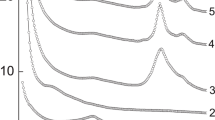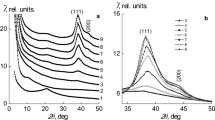Abstract
This paper investigates the structure, morphology and antimicrobial properties of silver-containing nanocomposites based on interpolyelectrolyte complexes (IPEC) of pectin with polyethylenimine, cationic starch or chitosan as a cationic polyelectrolyte. The reduction of silver ions was carried out by thermochemical technique by heating of the interpolyelectrolyte–metal complexes, which in turn prepared by adsorption of ions on IPEC. The chemical reduction was also performed using ascorbic acid as reductant. The temperature and time needed to produce the nanocomposites at which completely reduction of silver ions occurs are 150 °C and 30 min. It is revealed that during thermochemical reduction depending on the type of cationic polyelectrolyte (PEI, cationic starch, chitosan), silver nanoparticles with an average size of 4.1, 5.3 and 4.7 nm, respectively, are formed. Various mechanisms of thermochemical reduction for interpolyelectrolyte–metal complexes containing polymers with aminogroups or polymers with the glucopyranose units are considered. It is found that the silver-containing nanocomposites, formed by thermochemical reduction, exhibited higher antimicrobial activity against strains of S. aureus and E. coli than ones obtained using ascorbic acid.




Similar content being viewed by others
References
Al-Muhanna MKA, Hileuskaya KS, Kulikouskaya VI, Kraskouski AN, Agabekov VE (2015) Preparation of stable sols of silver nanoparticles in aqueous pectin solutions and properties of the sols. Colloid J 77:677–684
Biao L, Tan S, Wang Y, Guo X, Fu Y, Xu F, Zu Y, Liu Z (2017) Synthesis, characterization and antibacterial study on the chitosan-functionalized Ag nanoparticles. Mater Sci Eng C 76:73–80
Dara PK, Mahadevan R, Digita PA, Visnuvinayagam S, Kumar LRG, Mathew S, Ravishankar CN, Anandan R (2020) Synthesis and biochemical characterization of silver nanoparticles grafted chitosan (Chi-Ag-NPs): in vitro studies on antioxidant and antibacterial applications. SN Appl Sci 2:665
Demchenko VL, Kobylinskyi SM, Riabov SV, Shtompel VI, Iurzhenko MV, Rybalchenko NP (2020a) Novel approach to formation of silver-containing nanocomposites by thermochemical reduction of Ag+ ions in interpolyelectrolyte-metal complexes. Appl Nanosci. https://doi.org/10.1007/s13204-020-01368-0
Demchenko V, Riabov S, Kobylinskyi S, Goncharenko L, Rybalchenko N, Kruk A, Moskalenko O, Shut M (2020b) Effect of the type of reducing agents of silver ions in interpolyelectrolyte-metal complexes on the structure, morphology and properties of silver-containing nanocomposites. Sci Rep 10:7126. https://doi.org/10.1038/s41598-020-64079-0
Egorova EM, Kubatiev AA, Schvets VI (2016) Biological effects of metal nanoparticles. Springer
El-Rafie MH, El-Naggar ME, Ramadan MA, Foudaa MMG, Al-Deyab SS, Hebeish A (2011) Environmental synthesis of silver nanoparticles using hydroxypropyl starch and their characterization. Carbohyd Polym 86:630–635
Géczi Z, Hermann P, Kőhidai L, Láng O, Kőhidai Z, Mészáros T, Barόcsi A, Lenk S, Zelles T (2018) Antimicrobial silver-polyethyleneimine-polylactic acid polymer composite film for coating methacrylate-based denture surfaces. J Nanomater 2018:1–9
Guinier A (1994) X-ray diffraction in crystals, imperfect crystals, and amorphous bodies. Courier Corporation
Hebeish A, El-Naggar ME, Fouda MMG, Ramadan MA, Al-Deyab SS, El-Rafie MH (2011) Highly effective antibacterial textiles containing green synthesized silver nanoparticles. Carbohyd Polym 86:936–940
Hudzicki J (2009) Kirby-Bauer disk diffusion susceptibility test protocol. American Society for Microbiology, Washington, pp 1–13
Liu Z, Wang Y, Zu Y, Fu Y, Li N, Guo N, Liu R, Zhang Y (2014) Synthesis of polyethylenimine (PEI) functionalized silver nanoparticles by a hydrothermal method and their antibacterial activity study. Mater Sci Eng C 42:31–37
Matthews JL, Peiser HS, Richards RB (1949) The X-ray measurement of the amorphous content of polythene samples. Acta Crystallogr A 2(2):85–90
Ostaeva GYu, Papisov IM, Selishcheva ED, Arbuzov DE (2010) Mutual enhancement of the complexing properties of components in tertiary systems containing copper nanoparticles, poly(acrylic acid), and poly(ethylene glycol). Polym Sci B52:86–90
Pallavicini P, Arciola CR, Bertoglio F, Curtosi S, Dacarro G, D’Agostino A, Ferrari F, Merli D, Milanese C, Rossi S, Taglietti A, Tenci M, Visai L (2017) Silver nanoparticles synthesized and coated with pectin: An ideal compromise for anti-bacterial and anti-biofilm action combined with wound-healing properties. J Colloid Interface Sci 498:271–281
Raghavendra GM, Jung J, Seo J (2016) Step-reduced synthesis of starch-silver nanoparticles. Int J Biol Macromol 86:126–128
Rao KSVK, Reddy PR, Rao KM, Kumar SP (2015) A green approach to synthesize silver nanoparticles from natural polymer for biomedical application. Indian J Adv Chem Sci 3:340–344
Scherrer PJNGWG (1918) Estimation of the size and internal structure of colloidal particles by means of röntgen. Nachr Ges Wiss Göttingen 2:96–100
Shtompel VI, Demchenko VL, Sinelnikov SI, Radchenko OA, Riabov SV (2019) Structural peculiarity and thermomechanical properties of polyelectrolyte complexes and metal-containing nanocomposites based on functionalized starch and polyethyleneimine. Polym J 41:34–40 (in Ukrainian)
Su D, Li P, Ning M, Li G, Shan Y (2019) Microwave assisted green synthesis of pectin based silver nanoparticles and their antibacterial and antifungal activities. Mater Lett 244:35–38
Tummalapalli M, Deopura BL, Alam MS, Gupta B (2015) Facile and green synthesis of silver nanoparticles using oxidized pectin. Mater Sci Eng C 50:31–36
Twu YK, Chen YW, Shih CM (2008) Preparation of silver nanoparticles using chitosan suspensions. Powder Technol 185:251–257
Yong LV, Long Z, Song C, Dai L, He H, Wang P (2013) Preparation of Dialdehyde Chitosan and its Application in Green Synthesis of Silver Nanoparticles. BioResources 8:6161–6172
Zahran MK, Ahmed HB, El-Rafie MH (2014) Facile size-regulated synthesis of silver nanoparticles using pectin. Carbohyd Polym 111:971–978
Zezin AA (2016) Synthesis of hybrid materials in polyelectrolyte matrixes: control over sizes and spatial organization of metallic nanostructures. Polym Sci C 58:118–130
Zezin AA (2019) Synthesis of metal-polymer complexes and functional nanostructures in films and coatings of interpolyelectrolyte complexes. Polym Sci A61:754–764
Zhang W, Zhao X, Jiang Y, Zhou Z (2017) Citrus pectin derived silver nanoparticles and their antibacterial activity. Inorg Nano-Met Chem 47:15–20
Funding
The work was performed with financial support Grant from the National Research Foundation of Ukraine (Development of nanocomposite polymeric biomaterials with effective antiviral and antimicrobial effect and 3D printing technology of resulting products. Application ID 2020.01/0222).
Author information
Authors and Affiliations
Contributions
VD designed and directed the research. VD, SK, MI, MR, NR and OD carried out experiments. VD and SK analyzed and interpreted the data. VD and SK wrote the manuscript.
Corresponding author
Ethics declarations
Conflict of interest
On behalf of all authors, the corresponding author states that there is no conflict of interest.
Additional information
Publisher's Note
Springer Nature remains neutral with regard to jurisdictional claims in published maps and institutional affiliations.
Rights and permissions
About this article
Cite this article
Demchenko, V.L., Kobylinskyi, S.M., Rybalchenko, N.P. et al. Effect of cationic polyelectrolyte on the structure and antimicrobial activity of silver-containing nanocomposites based on interpolyelectrolyte complexes with a pectin anionic component. Appl Nanosci 12, 459–466 (2022). https://doi.org/10.1007/s13204-021-01670-5
Received:
Accepted:
Published:
Issue Date:
DOI: https://doi.org/10.1007/s13204-021-01670-5




